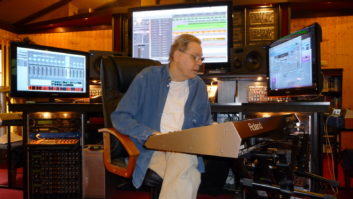Herb Alpert is still cutting tracks at 80, with the release of Come Fly with Me.
Herb Alpert’s rich musical life speaks volumes of his passion. As founder of the Tijuana Brass and the “A” half of A&M Records, Alpert’s career has been a labor of love, and his trumpet has never been far from his side. On his new album, Come Fly with Me, Alpert, who is 80 years old, invites listeners to take a journey with him through several new original songs as well as reworked jazz and rock standards including “Something,” “Take the A Train,” “Danny Boy” and others. In the process, we are swept into Alpert’s gifted trumpet playing and interpretation of melody. Pro Sound News caught up with the trumpet player-turned record executive-turned trumpet player again, only to learn that his career never stands still and that he hasn’t lost his touch.
On Repurposing Standards
Music is one of my major passions in life. I’m up here [picks up a trumpet and plays a scale] practicing every morning and thinking about music. When I find music that is fun for me to play, I feel like it might be fun for a certain amount of people to listen to. So I just collect songs that I like to play. One of my pursuits is to find a standard song that brings back memories to people, and play it in a way that it hasn’t been heard before. On this record, the one that is really unusual is “Take the A Train;” this song has always been played in 4/4 time and I did it in 3/4 time. I am always conscious of being faithful to the writers though; Stan Getz was a dear friend of mine, and he said, ‘If you can’t improve on a melody, don’t fool around with it.’
On “Transporting Music”
On Come Fly with Me, I got the idea of having a specific destination—so I added a steel drum player and it kind of transported you to the Caribbean, which I thought was a nice little touch. The first record that started A&M was “The Lonely Bull” in 1962: out of the box, it was a big hit. While the record was in the top 10, I got a letter from a lady in Germany who thanked me for sending her on a vicarious trip to Tijuana. I chuckled when I got the letter. I thought to myself, “Wow—that music was so visual to her that it was transporting.” That’s the type of music I really want to make: music that takes you someplace as opposed to elevator music, which is not memorable.
On the Origins of Tijuana Brass
The audio industry has changed so dramatically since I started. Believe it or not, when I started recording, I had a Webcore wire recorder. That was before tape. If you wanted to edit, you did it with a soldering iron! Then I started using mono Ampex machines. When I heard Les Paul layering his guitar on ‘How High the Moon’ in the late ’50s, I started doing that with the trumpet, going from machine to machine. I started layering this sound that intrigued me, and that was the genesis of the Tijuana Brass sound.
On His Great Friend
The trumpet has been pretty darn good to me over the years. When I was eight years old, there was a music appreciation class in my elementary school and I discovered the trumpet. I was super shy as a kid, and when I finally found out how to make a sound out of the horn, it was speaking for me. Through the years, it has been a great friend of mine, and in 1969, it turned against me. I was going through a divorce and having some emotional problems and I couldn’t play it. Then I worked it out; a great teacher in New York, Carmine Caruso, taught me the physics of playing a horn and here I am at 80, playing better than I ever have, and doing it with less effort. Once you become a musician and a professional, it is a never-ending process and there is always more to learn. Dizzy [Gillespie] used to say, ‘The closer I get, the farther it looks.’ I love that quote, because that is the truth. You never quite get to where you want to go and that is the beauty of it.
On “Something”
I am a melody guy—when the melody is strong, it always resonates with me. I always loved George Harrison’s “Something,” and I always felt it was one of The Beatles’ strongest songs. One day, Michael Shapiro was playing a slow groove, and I just played it against the drum and it felt good. Then we added the bass and just left it like that. It was very transparent and open. I think that whole cut feels very real and honest—it is not trying too hard to be a hit recording.
On Honesty and Authenticity
There’s a quality that is very important for musicians and artists to understand. Something happens that is not quite perfect, but it is real, honest and authentic. I think the great artists—Miles Davis, John Coltrane, Stan Getz, Thelonius Monk—didn’t care whether you liked their music or not, but their songs had to fit their sense of musicality before they put their stamp of approval on it. One of the things that distracts a lot of artists is that they look for perfection. Is it in tune, or out of tune? Am I perfectly in time? Then when you think of the great artists like Billie Holliday, well, she had things you could complain about. But man, her music touched you. And that is the only measure.







